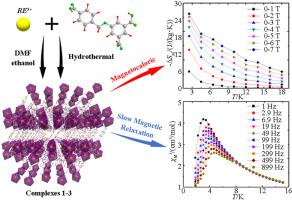Journal of Rare Earths ( IF 5.2 ) Pub Date : 2021-05-11 , DOI: 10.1016/j.jre.2021.04.009 Zhenqian Zhang , Yuwei Wu , Haifeng Wang , Lingwei Li

|
Three binuclear rare earth based complexes combining RE ions with semirigid tricarboxylic ligand (H3L), namely, [RE2(L)2(DMF)4] [RE = Gd, Tb, and Dy; H3L = 5-((4-Carboxybenzyl)oxy)isophthalic acid; DMF = N,N-dimethylformamide] complexes, were fabricated successfully. The RE2(L)2(DMF)4 complexes consist of two central RE ions with the same coordination environment which were connected by two tridentate bridging carboxylic groups and two syn–syn bidentate bridging carboxylic groups originating from the L3− ligands to form the {RE2} dimeric unit, and thus provides the basis for further constructing a dense three-dimensional (3D) network structure. Moreover, the present RE2(L)2(DMF)4 complexes can be described by a topology diagram with the topology point symbol of {42·6}2{44·62·87·102}. Weak anti-ferromagnetic (AFM) coupling between the adjacent RE ions for all the present complexes was found according to the magnetic calculations. The observed significant cryogenic magnetocaloric effect (MCE) with the maximum magnetic entropy change to be 26.3 J/(kg·K) with = 7 T in Gd2(L)2(DMF)4 complex makes it competitive for the cryogenic magnetic refrigerant. Moreover, the slow magnetic relaxation behavior at 0.2 T dc field with an obvious large = 45(4) K and = 6.5(2) × 10−10 s was confirmed in Dy2(L)2(DMF)4 complex. This work not only provides an effective strategy for obtaining molecular materials with high MCE, but also confirms that tricarboxylate ligands are the ideal choice for constructing stable high dimensional geometric structures.
中文翻译:

基于稀土的双核 RE2(L)2(DMF)4(RE = Gd、Tb 和 Dy)配合物的磁热效应和慢磁弛豫行为
稀土离子与半刚性三羧酸配体 (H 3 L)结合的三种双核稀土基配合物,即 [RE 2 (L) 2 (DMF) 4 ] [RE = Gd、Tb 和 Dy;H 3 L = 5-((4-羧基苄基)氧基)间苯二甲酸;DMF = N,N-二甲基甲酰胺] 配合物,成功制造。RE 2 (L) 2 (DMF) 4配合物由两个具有相同配位环境的中心 RE 离子组成,它们通过两个三齿桥接羧基和两个源自 L 3-配体的顺-顺二齿桥接羧基连接形成那里2 }二聚体单元,从而为进一步构建密集的三维(3D)网络结构提供了基础。此外,目前的RE 2 (L) 2 (DMF) 4配合物可以用拓扑图来描述,拓扑点符号为{4 2 ·6} 2 {4 4 ·6 2 ·8 7 ·10 2 }。根据磁性计算发现了所有现有配合物的相邻稀土离子之间的弱反铁磁(AFM)耦合。观察到具有最大磁熵变化的显着低温磁热效应(MCE)为 26.3 J/(kg · K) = 7 T in Gd 2 (L) 2 (DMF) 4配合物使其在低温磁性制冷剂方面具有竞争力。此外,0.2 T dc 场下的慢磁弛豫行为具有明显的大 = 45(4) K 和 = 6.5(2) × 10 -10 s 在 Dy 2 (L) 2 (DMF) 4复合物中得到证实。该工作不仅为获得具有高MCE的分子材料提供了一种有效的策略,而且证实了三羧酸盐配体是构建稳定的高维几何结构的理想选择。











































 京公网安备 11010802027423号
京公网安备 11010802027423号